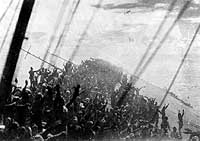
In the early afternoon of 25 October 1944, after the third U.S. air attack of the day, Zuikaku was stopped, listing severely to port, and clearly sinking. Surviving crewmen mustered on the flight deck, gave a final "Banzai" cheer and abandoned ship. Zuikaku, last of the six carriers that started the Pacific War with the Pearl Harbor attack almost three years earlier, capsized and sank shortly afterwards.
However, her sacrificial mission had been successful. A powerful Japanese surface force, headed by the huge battleship Yamato, entered the Pacific, and, as Zuikaku and her consorts were undergoing the first of the day's fatal attacks, encountered a force of U.S. escort carriers, producing the epic Battle off Samar.
This page features images of Zuikaku after she had been stopped and was sinking during the Battle off Cape Engano, 25 October 1944.
For views of Zuikaku in this action, taken while
she was still underway, see:
For for other photographs of Zuikaku , see:
| If you want higher resolution reproductions than the digital images presented here, see: "How to Obtain Photographic Reproductions." |
Click on the small photograph to prompt a larger view of the same image.
|
Photo #: NH 95544 Battle off Cape Engano, 25 October 1944 Japanese aircraft carrier Zuikaku dead in the water, listing and afire (center), at about 1400 hrs., 25 October, following the day's third attack on the Japanese force. Ship maneuvering at right is the battleship Ise. Photographed from a USS Enterprise (CV-6) plane. Copied in 1985 from an original print in the USS Enterprise report of the action. U.S. Naval History and Heritage Command Photograph. Online Image: 88KB; 740 x 615 pixels |
 |
|
Photo #: 80-G-272556 Battle off Cape Engano, 25 October 1944 Japanese ships under attack by Task Force 38 aircraft, during the afternoon of 25 October. Carrier Zuikaku is dead in the water and smoking in the left center. Light carrier Zuiho is underway at the left, nearer to the camera. Photographed from a USS Franklin (CV-13) plane. Note anti-aircraft shell bursts overhead. Official U.S. Navy Photograph, now in the collections of the National Archives. Online Image: 78KB; 740 x 580 pixels Reproductions of this image may also be available through the National Archives photographic reproduction system. |
 |
|
Photo #: NH 95786 Battle off Cape Engano, 25 October 1944 Japanese warships maneuvering under attack by U.S. Navy carrier aircraft, during the afternoon of 25 October. Bombs are falling near the light carrier Zuiho, in lower left center. The large carrier Zuikaku is burning and apparently dead in the water in the right center distance. Nearest of the two ships at left, beyond Zuiho, is an Akizuki class destroyer. Note anti-aircraft shell bursts overhead. Photographed from a USS Franklin (CV-13) plane. Copied in 1986 from an original print (photo # 26) in the TG38.4 action report of 18 November 1944. U.S. Naval History and Heritage Command Photograph. Online Image: 65KB; 740 x 605 pixels |
 |
|
Photo #: NH 73071 Battle off Cape Engano, 25 October 1944 Crewmembers of the listing Japanese aircraft carrier Zuikaku throwing explosives over the side, after she had been damaged by U.S. carrier aircraft on 25 October. Photographed from the carrier's island, looking to port. Courtesy of Mr. Kazutoshi Hando, 1970. U.S. Naval History and Heritage Command Photograph. Online Image: 142KB; 740 x 570 pixels |
 |
|
Photo #: NH 73069 Battle off Cape Engano, 25 October 1944 Crewmembers salute as the Japanese Naval Ensign is lowered on the sinking carrier Zuikaku, during the afternoon of 25 October. View looks aft from the rear of the carrier's island, with radio antenna masts folded horizontal on her starboard side. Note her sharp list to port. A 25mm single anti-aircraft machine gun is mounted on the flight deck, at the lower right. Courtesy of Mr. Kazutoshi Hando, 1970. U.S. Naval History and Heritage Command Photograph. Online Image: 88KB; 740 x 550 pixels |
 |
|
Photo #: NH 73070 Battle off Cape Engano, 25 October 1944 Crewmembers of the sinking carrier Zuikaku give a final "Banzi" cheer after the Japanese Naval Ensign was lowered, during the afternoon of 25 October. View looks aft from the rear of the carrier's island, with radio antenna masts folded horizontal on her starboard side. Note the sharp list to port. Courtesy of Mr. Kazutoshi Hando, 1970. U.S. Naval History and Heritage Command Photograph. Online Image: 95KB; 740 x 545 pixels |
 |
For views of Zuikaku in this action, taken while
she was still underway, see:
For for other photographs of Zuikaku , see:
NOTES:
| If you want higher resolution reproductions than the digital images presented here, see: "How to Obtain Photographic Reproductions." |
Page made 20 May 2000
Coding updated 3 May 2009